In June of last year, Portland was hit with its highest temperatures on record, reaching 116 degrees in some areas. The heat wave — caused by a “heat dome” that trapped hot air across the Pacific Northwest — killed dozens of people.
Like with most natural disasters, the impacts of the heat wave were felt unequally. People in low-income neighborhoods — crowded with large roads and parking lots that radiate heat — endured the highest temperatures. In Portland, greener and wealthier neighborhoods west of the Willamette River can be nearly 25 degrees cooler during heat waves than those on the east side.
That means people in east Portland, especially people who don’t have air conditioning, are more likely to die during a heat wave.
One of the biggest factors playing into neighborhood temperature is a lack of tree shade. A spot under a tree can be up to 45 degrees cooler than one exposed to the sun. Collectively, shade trees lower overall temperatures by adding moisture to the air.
So it may have come as a surprise to many Portlanders this spring when they learned that the city, despite its reputation for being among the country’s greenest cities, is actually losing tree canopy. Then, shortly after city officials published a report documenting its tree losses, they decided not to renew a project that has helped the city plant 40,000 trees in the last 15 years.
Why would city officials, nearly a year after a catastrophic heat wave and at a time when tree canopy seems most crucial, end one of its most successful tree-planting partnerships? OPB reviewed hundreds of internal emails and interviewed 16 people who work with and within the city. They revealed a yearslong power struggle between city bureaus that appears to have cut the number of annual tree-plantings that are key to the city achieving its tree canopy goals — and, in the process, protect the people most vulnerable in extreme weather.

Multnomah County officials say 72 people died from heat illness during a massive heat wave in June 2021.
April Ehrlich / OPB
In any other major city, this would be a time when the mayor or city manager could mediate. But Portland operates under an unusual commission style of government, wherein city bureaus are managed by individual council members. Things could change with a ballot initiative this November, when city voters will decide if they would rather have a professional city manager coordinating city services and policies.
Critics of the commission system say it discourages collaboration and encourages commissioners to prioritize their bureaus over broader city needs. The fight over trees offers a case study, in which two Portland bureaus — the Bureau of Environmental Services and the Bureau of Parks and Recreation — are competing for the power that comes with managing trees. The end result appears to be fewer trees being planted and cared for in the coming years, even as temperatures continue to rise.
Losing Friends of Trees
Portland city officials issued an announcement this spring that puzzled many: After nearly 15 years, the city wasn’t renewing its five-year contract with Friends of Trees, a locally beloved nonprofit that has helped the city plant tens of thousands of trees.
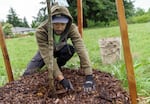
Armani Thomas, a neighborhood tree specialist with the Friends of Trees, spreads mulch around a big leaf maple planted at Columbia View Park in Gresham, July 6, 2022. Portland city officials ended their contract with Friends of Trees, which has helped plant tens of thousands of trees in the city.
Kristyna Wentz-Graff / OPB
Every planting season for the last three decades, Friends of Trees has brought together hundreds of volunteers during planting events throughout Portland and nearby cities. During its street-tree planting events, it focuses on a specific neighborhood and asks homeowners if they’d like a free tree in the parking strip — the small area of grass between the street and sidewalk — in front of their homes. Homeowners can also purchase trees to have them planted in their yards or parking strip. Volunteers help plant the trees during planting events, and Friends of Trees educates homeowners on how to care for them to ensure the new trees take root and develop a hearty canopy.
Portland city government had two contracts with Friends of Trees; the biggest one belonged to the Portland Bureau of Environmental Services, also known as BES, a bureau that manages sewer and wastewater utilities. Trees naturally soak up and filter stormwater before it enters the sewer system, so the Bureau of Environmental Services in 2008 started a “green infrastructure” program to plant street trees as a sustainable way of treating rain water. The bureau first signed a seven-year contract with Friends of Trees, the only major organization up for the job at the time, amounting to $7.85 million. It was renewed in 2016 as a five-year contract amounting to $5.88 million, covering the costs of neighborhood outreach, planting about 12,000 trees, and pruning about 8,450 trees.
By partnering with Friends of Trees, the bureau tapped into the plethora of Portlanders who love trees and are willing to volunteer their time planting them in front of other people’s homes. But in order to implement the program, BES needed a permit from another city bureau: Portland Parks and Recreation, specifically its Urban Forestry department.
The two bureaus had worked together well for the most part, until recently.
“In the last, boy, five years, things really took a turn for the worst,” said Matt Glazewski, formerly the senior policy advisor for Portland Commissioner Mingus Mapps, who oversees BES. Glazewski worked during Mapps’ first six months in office and says he left in May 2021 on good terms. Glazewski is now the dean of physical sciences at Portland Community College.
“It became a lot less collaborative, and it was a problem that was festering,” Glazewski said.
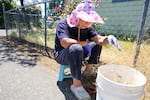
Winnie Lee removes plants at her home on July 8, 2022. Her Lents home benefits from little tree cover.
Jenna Deml / OPB
The permit from Urban Forestry gave Environmental Services the permission it needed to plant trees with Friends of Trees. It also outlined performance measures that Environmental Services needed to follow; if the agency didn’t meet them, the urban forester had the power to revoke the permit. Those measures included what percentage of trees Environmental Services needed to plant in low-income or low-canopy neighborhoods, the types of trees planted, how big those trees needed to be, as well as specific planting and pruning processes.
Multiple sources who work with and within the city, who ask not to be named out of fear of retribution, say Urban Forestry increasingly made the permit’s performance measures more difficult to achieve. For instance, they said later versions of the permit required Environmental Services to plant specific types of trees that weren’t always available.
In the most recent iteration of the two-year permit, Urban Forestry provided a list of 325 trees that Environmental Services was allowed to plant, but the bureau had to choose a diverse selection following a careful formula outlined within the permit. Of the around 2,700 street trees planted in one season, no more than 30% could come from the same tree family; no more than 20% could come from the same genus; and no more than 10% could be the same species. (Tree families are the broadest classification of tree types, and genera is a subgroup of families; for example, fagaceae is a tree family that includes eight genera, including beeches, chestnuts and oaks. Tree species is the most specific classification of tree; for example, there’s the European beech, the fernleaf beech, or the copper beech.)
In addition to those specifications, at least 10% of trees planted needed to be evergreens, 10% needed to be native species, 40% needed to have a large canopy (in that they provided the most shade), and 40% needed to have a medium canopy. At least 80% needed to be planted in low-canopy neighborhoods and 30% in low-income neighborhoods.
In 2019, the city hired consultants to assess how Environmental Services and Parks programs could work better together. Staff from the two bureaus said they don’t know how much that work cost or where the money came from.
“We do not have details related to the costs for the consultants,” spokesperson Cherelle Jackson wrote to OPB by email. “This was under Commissioner [Nick] Fish and led by the Bureau Directors and Deputy Directors, and funding was handled at that level.”
At that time, Fish oversaw both bureaus. He had been commissioner for the city for 11 years until he died in 2020 of stomach cancer.
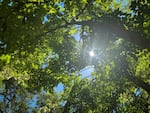
The sun peers through tree canopy at the Leach Botanical Garden in Southeast Portland on June 27, 2022, during the first of a series of events called "Heat Week" commemorating the dozens of people who died during a massive heat wave the year before.
April Ehrlich, April Ehrlich / OPB
The consultants published a report of their findings in February 2020. In that report, Environmental Services staff said the tree-planting stipulations outlined in Urban Forestry’s programmatic permit were “unrealistic and unachievable.” They said there weren’t enough large parking strips in the city to accommodate the permit’s 40% rule for large-canopy trees, particularly in the low-canopy neighborhoods where they were supposed to focus tree-planting efforts. The report says BES had “generally met the performance measures” for planting in low-income and low-canopy neighborhoods, but it was less successful in meeting goals for large-form, native and evergreen trees.
Over time, Environmental Services was increasingly unable to meet the permit’s stipulations.
Urban Forestry leaders used that as a reason for moving the street tree program under Urban Forestry’s control.
“The programmatic permit has not been successful; more direct management and oversight by [Parks and Urban Forestry] is required for improvement,” Urban Forester Jen Cairo wrote in an email to colleagues.

On Feb. 5, 2021, Portland Urban Forester Jen Cairo outlined her idea for an interagency agreement between Parks and Recreation and the Bureau of Environmental Services, in which she suggested BES’s tree-planting program and its tree-planting funds be moved to her department. She told OPB this year that she was “not familiar with that at all.”
City of Portland records
In that email, written in February 2021, Cairo told colleagues that Urban Forestry shouldn’t give Environmental Services another permit; instead, she wrote, the two bureaus should sign an interagency agreement moving the street-tree program to Urban Forestry.
Cairo also suggested that Environmental Services should continue paying for the program using utility ratepayer dollars — money customers pay for stormwater and sewer services. It appeared Cairo wanted full control of the program that BES had built from scratch almost 15 years ago, but she wanted BES to pay for it.
“We’d like to see BES’s investment in street tree planting continue at the same level it’s been (if not more!),” Cairo wrote to a colleague in June 2021 in an email OPB obtained through a public records request.
In a video interview with OPB, Cairo denied having ever heard of this proposal.
“I’m not familiar with that at all,” she told OPB.
Several emails and messages obtained by OPB counter that. Multiple times, in emails sent to Parks colleagues as well as staff at Environmental Services, Cairo carefully outlined what she envisioned for the future of the two bureaus and the street tree program: “PP&R [Portland Parks and Recreation] will ensure planting of 1,000 trees/ year funded by BES and on behalf of BES. BES will not house a tree planting program.”
Even members of the Urban Forestry Commission, an advisory group made up of volunteers, seemed to find the request far-fetched.
“There is no way in the world [BES is] going to give their money to another bureau that has treated them the way they’ve been treated,” said Urban Forestry commissioner Bruce Nelson in an interview with OPB. “But for some reason, I think Jen might have honestly thought that they would get that money.”
Forestry commission members, including Nelson, wanted to hear directly from Environmental Services leaders about how the bureau’s street-tree program worked. BES was initially scheduled for the commission’s September 2021 regular meeting, but Cairo stepped in, according to internal staff emails obtained by OPB. She told Brian Landoe, who sets the agendas, to tell Environmental Services leaders that they misunderstood him: “you’re clarifying that BES is not presenting; rather the City message, when complete, will be provided to the UFC (and others).”
Rather than allowing BES to speak directly to the Urban Forestry Commission, which serves as an advisory group to her department, Cairo insisted that messaging from BES go through her.
When asked about why BES never made it onto the commission’s agenda, Cairo said in a video interview with OPB that the commission needed to focus on “tree code amendments and other city policies that affect trees,” and information about BES’s tree-planting program should go through her.
In emails within the agency obtained by OPB, BES employees complained to each other about the behavior from Urban Forestry management. They described being bullied and misled by the department’s leaders.

After not renewing its Friends of Trees contract, the Bureau of Environmental Services has pivoted to only planting trees on private property. Emails obtained by OPB through a public records request show that some BES staffers didn’t think it was a good idea. On April 1, 2021, BES staffer Matt Krueger, who manages the bureau’s tree-planting program, wrote to manager Marveita Redding that the transition was to avoid Urban Forestry “hassles” and that it wouldn’t be “our first choice.”
City of Portland records
Portland Commissioner Carmen Rubio oversees the Parks and Recreation bureau. Rubio said she doesn’t often meet directly with Cairo, so she couldn’t speak to the complaints about the urban forester from BES.
“I can tell you that when I do, she’s very deeply passionate and knowledgeable about trees and, quite frankly, she brings strong opinions to the mission to protect them and build the tree canopy,” Rubio said.
Cairo wouldn’t comment on the complaints about her management style. Responding on her behalf, Parks and Recreation spokesperson Cherelle Jackson said the bureau wouldn’t comment on “rumors about a member of our team.”
“Unfortunately, too many women in male-dominated industries like forestry face this behavior,” Jackson wrote in an email to OPB. “As a Bureau, we will uphold our values for equality and respect for women in the workplace. If you have evidence that is not based on hearsay, please feel free to share, and we may respond accordingly.”
The two bureaus ultimately never signed an interagency agreement. Urban Forestry allowed Environmental Services to extend its contract with Friends of Trees for one more year, so it was set to end this spring. In March 2022, the city announced the group’s work with Environmental Services wouldn’t be renewed.
“They continue to want it all,” Marveita Redding, senior manager at BES, emailed a colleague in April 2021. “Even the minimal contract extension with Friends of Trees is unacceptable to UF.”
Misleading information from bureaus, commissioners
On the back end, city officials seemed well aware of the public backlash they’d receive once they announced that they wouldn’t renew the BES contract with Friends of Trees. BES public information officer Diane Dulken in April coached city staff by email to assure the public that Portland’s relationship with Friends of Trees is not ending, “it is evolving,” a phrase that appears several times in internal staff emails about public messaging.
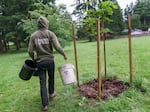
Armani Thomas, a neighborhood tree specialist with the Friends of Trees, finishes mulching and inspecting some big leaf maples planted at Columbia View Park in Gresham, July 6, 2022.
Kristyna Wentz-Graff / OPB
Parks and Recreation staff, meanwhile, frequently note in public messaging that their bureau still has an active contract with Friends of Trees.
“Friends of Trees was allocated [$139,000] for this tree planting season, which they have not fully utilized,” an April 2022 press release from the bureau reads. “They are eligible to provide up to $1 million in contracted on-call services annually, under this contract with [Parks and Recreation.]”
The statement, according to Friends of Trees, lacks some important context. According to that statement, the Parks contract with Friends of Trees has resulted in just 130 trees planted over the five-year agreement — a fraction of the 12,000 trees planted through the five-year contract with BES. The Parks contract also forbids Friends of Trees from using volunteers to plant trees.
The Parks and Recreation contract is on an on-call basis, meaning the bureau provides a list of addresses to Friends of Trees, then the nonprofit plants trees at those addresses. Its executive director, Yashar Vasef, said the bureau made an unexpected request for planting trees at 80 addresses in February, in the middle of planting season. Because of the timing, Friends of Trees denied the request.
“We turned that away, because it was during peak planting for us,” Vasef said.
Parks staff and Rubio’s office point to the incident as a sign Friends of Trees isn’t eager to work with the city. Jillian Schoene, Rubio’s chief of staff, told OPB in an email that “FOT has refused work under current, active contracts.”
Vasef said that wasn’t true.
“We are completing every aspect of our existing city contracts, like we have done for well over a decade with the City of Portland,” Vasef wrote in an email.
Schoene later clarified by email: “Sorry, I misspoke – I meant an extension they were offered. I want to dig into that.”
Bureau managers from BES and Parks insisted on a joint interview with OPB, as did the two Portland commissioners overseeing the bureaus. They said the bureaus were working well together and the city was well on its way to meeting its tree-canopy goals.
“A lot of the previous tensions are actively being resolved,” Rubio said.
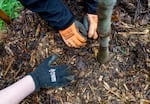
During a training with Friends of Trees on July 6, a group of Gresham youth learn how to properly mulch and care for big leaf maples planted at Columbia View Park in Gresham. Friends of Trees not only care for the environment, but also work to connect historically marginalized communities with the city.
Kristyna Wentz-Graff / OPB
Commissioner Mapps, who oversees the Bureau of Environmental Services, said that while his agency won’t be planting street trees this year, BES isn’t entirely out of the tree-planting game.
“In fact, we’re actually growing our tree-planting program,” Mapps said. “Last year, [BES] spent $1.2 million. This coming fiscal year, we’ll spend $1.6 million.”
While BES has $1.6 million budgeted for tree-planting for the 2023 fiscal year, the loss of its street-tree program brings that number down to $600,000 in planned spending, according to BES staff.
Staff with Rubio’s office, meanwhile, say the city is planning to spend $30 million to $50 million on tree planting and maintenance over the next decade, money that would come from the Portland Clean Energy Community Benefits Fund.
The program, approved by voters in 2018, taxes large corporations on their Portland sales to provide a pot of funding for nonprofits looking to start projects aimed at advancing both climate and racial justice.
“...PCEF is planning to spend $30-50 million on tree planting in East Portland,” Will Howell, Rubio’s communications director, wrote in an email to OPB.
Staff with the clean energy fund say the dollar amount isn’t that simple or that certain. A nine-person volunteer committee situated within the city’s Bureau of Planning and Sustainability considers applications for clean energy fund money and recommends recipients to the city council.
“We made a presentation to Council stating an example budget for tree-planting projects could include $30 to $50 million over a ten-year span for planting and maintenance,” Magan Reed, public information officer with the Bureau of Planning and Sustainability, wrote in an email to OPB.
Reed added that PCEF leaders “absolutely plan to invest in tree planting and maintenance,” but it was impossible to know exactly how much money could be invested.
When OPB asked for further clarification from Reed and Howell, Reed said the $30 million to $50 million was a commitment from Rubio’s office, not from from the clean energy fund staff.
“We’re not going anywhere”
The contract between BES and Friends of Trees officially ended on June 30. BES is still planting trees, but only on private property, not on the parking strips that are designated public rights-of-way. It doesn’t need permits from Urban Forestry for this work.
Urban Forestry, meanwhile, launched its own street-tree program, one that aims to plant up to 1,200 trees per year — less than half of the number of trees that BES was planting with Friends of Trees.
There are other key differences between the two street-tree programs. BES’s program was funded by payments from utility customers, while the Urban Forestry program is funded by permits that developers buy when they need to remove trees.
Urban Forestry’s program also uses an “opt-out” model, in that the department identifies locations in low-canopy neighborhoods where street trees can be planted, and unless the homeowner specifically says they don’t want a tree, they get one. The department mails about three letters to homeowners, giving them an opportunity to decline the tree. Otherwise, contractors show up and plant a tree in front of their house.
There isn’t a volunteer planting event; the planting is done by paid professional contractors. The city waters and prunes trees for their first three years, but after that, homeowners are responsible for all costs associated with tree maintenance.

Armani Thomas, a neighborhood tree specialist with the Friends of Trees, inspects buds on a big leaf maple planted at Columbia View Park in Gresham. Friends of Trees regularly monitors the health of trees they have planted in the community, and replaces them if the need arises.
Kristyna Wentz-Graff / OPB
“What’s it going to be like when that tree gets big and needs to be pruned?” said Ted Labbe, Executive Director of the Urban Greenspaces Institute, a nonprofit that advocates for environmental policies. “What happens if that tree needs to come down, and they have to pay an arborist like $10,000 to take it down? What the city is doing with their opt-out model is they are creating an additional burden on Portlanders who cannot afford this kind of burden.”
By contrast, Friends of Trees’ former street tree program with BES used a “community engagement” model, in that they reached out to homeowners in a neighborhood and asked if they wanted a free street tree. If a homeowner said yes, they were able to pick out the species of tree they wanted, and volunteers provided information about tree maintenance. Then the nonprofit hosted a large tree-planting event with dozens of volunteers, and homeowners were invited to help plant their own trees.
Labbe said Friends of Trees was able to engage community members in low-income neighborhoods who, due to a long history of abuse and marginalization, may have been wary of government programs. Friends of Trees bridged the connection between those communities and the city. In recent years, Friends of Trees has partnered with community organizations that work primarily with historically marginalized groups, including Verde, Portland Opportunities Industrialization Center, Wisdom of the Elders, and others.
“There are so many qualitative benefits from bringing community members together to plant trees,” said Vasef, Friends of Trees’ executive director.
Neighbors sometimes meet each other for the first time at Friends of Trees’ planting events, Vasef said.
“Those are the kind of stories that you don’t get when an employee of the city comes out, plants a tree in the right-of-way, and then goes on to the next spot,” Vasef said.
Portland’s contract made up about a third of the nonprofit’s revenue. According to its 2020 annual report, Friends of Trees’ yearly revenues added up to $2.9 million, and Portland’s contract paid about $1 million every year.
Even so, Vasef said the lost money isn’t an issue, since some of the nonprofit’s expenses have decreased along with the loss of that contract. It’s also starting to garner more revenues through individual donations, local businesses, and contracts with other cities, Vasef said.
“Friends of Trees is going to continue doing its thing, one way or another,” Vasef said. “What we are seeing is increased investment in our work through the 20 to 30 municipalities that we work with up and down the Willamette Valley and into Southwest Washington. We’re not going anywhere.”
